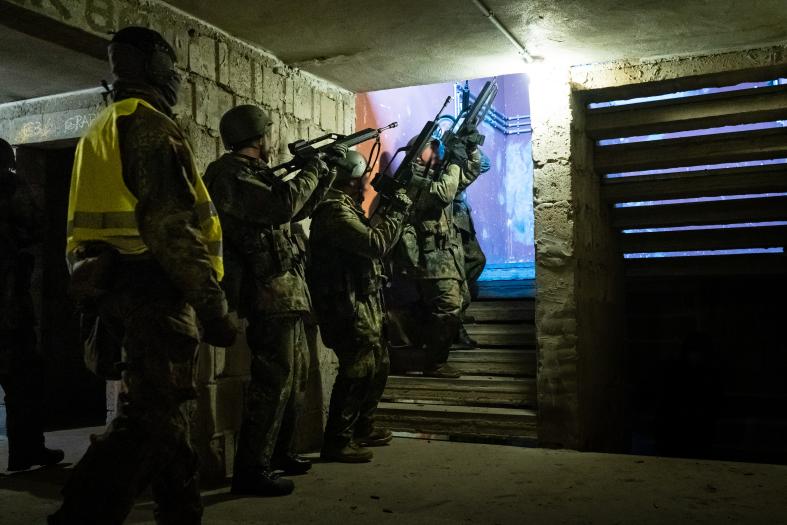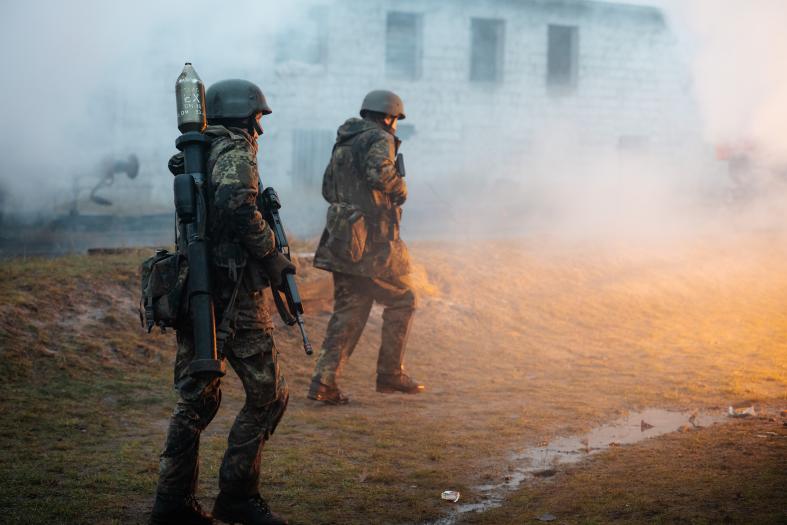Fighting in Complex Terrain – EUMAM UA infantry training

Since February 2022, the Ukrainian military has been defending its homeland determinedly against Russia’s attack – an attack in violation of international law. While in the beginning of the armed conflict the focus was on defending urban or strategically important areas, the Ukrainian armed forces are now confronted with entirely new areas of operation due to their counteroffensive. To the soldiers, the Russian line of defence poses challenges which to some extent already characterized World War II 80 years ago: widespread defensive fighting positions with minefields extending over distances of several kilometres. Given that the use of armoured fighting vehicles has proven ineffective for the Ukrainians under these conditions, the Ukrainian military is increasingly counting on infantry again to clear the Russian fighting positions. The “Fighting in Complex Terrain” training is supposed to prepare the Ukrainian infantrymen and women for operations in urban areas or defence fighting positions as well as for operations in wooded terrain.
Approach to contact
At a Training Centre North training area, German paratroopers and a Ukrainian infantry company are preparing for the training day ahead. The Ukrainian soldiers are already familiar with handling weapons and ammunition. The majority of them come from areas that are located on the frontline and have already been deployed to defend their homeland. Within four weeks, they are supposed to learn tactical principles in Germany in order to be able to take effective military action in different operational areas as a squad, platoon or company.
Already before sunrise, they reach today’s exercise area. At this point, the platoon leader receives his first mission in a thick wooded area, not far from a training village. The platoon is supposed to capture the railway building, a place of strategic importance. The railway station is located behind the training village, where enemy forces have readied themselves for defence. The platoon leader instantly analyses the situation to plan further actions and brief his soldiers by issuing orders. Afterwards, the first phase of the attack begins and the platoon, divided into three squads, approaches the forest edge slowly. The soldiers are alert and careful because they could encounter enemy forces at any point in time, also outside the village. Having arrived at the edge of the forest, the soldiers move into position. They know the task ahead and make final preparations.
Attack
Two smoke grenades, also called smoke pots, are thrown and accurately land between a close-by building and the position of the first squad. The smoke is supposed to obscure the enemy forces’ view of the soldiers’ actions so that these can advance, preferably undetected. The squad leader eventually yells his order and the soldiers launch the assault on the building, protected by the covering fire of the second squad.
Close quarters combat, that is fighting at close and very close distance with all means, requires flexibility and good coordination within the squad. In buildings with complex layout or in trench systems, enemy forces have to be fought effectively in a matter of seconds without causing friendly fire (i.e. firing on own or allied forces). So, the soldiers work their way forward, from room to room, from floor to floor, until they have captured and secured the entire building. However, their mission has not yet been accomplished. This building is only a necessary intermediate objective to even enable the capture of the railway building.
Suddenly the squad is under fire. There are more enemy forces in the building opposite. However, the squads are already too far apart to take action on another building. The squad leader immediately requests reinforcement via radio. It is now important to maintain the attack momentum and advance to the second building as fast as possible. While the second squad keeps providing covering fire, the two assault squads manage to join forces and together capture the second building as well. One last time the forces are coordinated by the platoon leader with a short combat order before the attack on the railway building begins.
Training for the frontline
“There is still some room for improvement”, one of the trainers explains during the final evaluation. It is especially the coordination of the forces and the protection of own soldiers that pose the biggest challenges to any armed forces in this special training. However, the Ukrainian soldiers are highly motivated and already in the next scenario they are able to remedy some of the mistakes they made before. In the demanding trainings, they are challenged up to 12 hours a day, six days a week. This is the only way for them to learn all the necessary abilities and tactics in such a short amount of training time. It will only be a few days until they will return to the frontline. As infantrymen and women, they have one of the most dangerous missions there, and not all of them will survive this deployment. This is why it is even more important to make the best possible use of the available training time in order to increase the survival chances of the Ukrainian soldiers on the battlefield.
By Lea Bacherle







